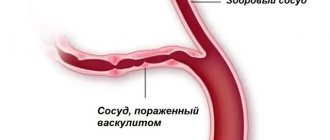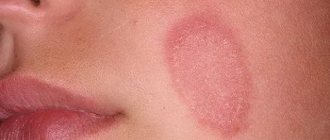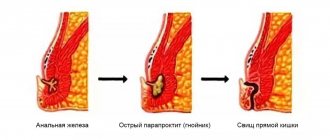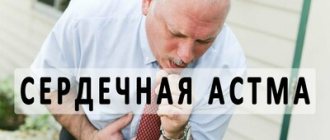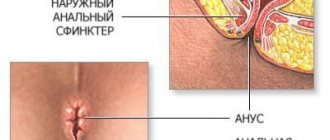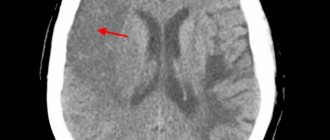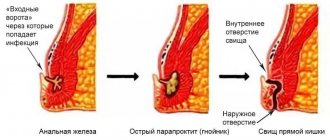Causes of rectal fissure
Most often, it is not possible to establish the exact cause of a rectal fissure. It is believed that the development of the disease can lead to:
- disturbances of blood flow in the walls of the anus (in people with heart and vascular diseases, in those who have to sit or stand in a monotonous position for a long time);
- prolonged constipation or diarrhea;
- inflammation of the mucous membrane of the rectum and anus;
- injuries to the mucous membrane (including during anal sex, medical procedures);
- diseases of the digestive system: gastritis, colitis, cholecystitis;
- eating large amounts of spicy food and alcohol;
- heavy physical activity;
- woman's injuries during childbirth.
The most effective suppositories for hemorrhoids according to buyers
This section includes suppositories that received the largest number of positive reviews from patients with the initial stages of the disease.
- Methyluracil is an effective drug with a pronounced immunostimulating and anti-inflammatory effect. The use of this drug allows achieving remission in 95% of patients. It accelerates the healing of damage to the mucous membrane and stimulates epithelial renewal. Another advantage of the drug is its price - less than 100 rubles.
- Nigepan. These suppositories have analgesic, anti-inflammatory and thrombolytic effects. Its cost ranges from 400 to 500 rubles.
- Proctosan is a medicinal product with a natural composition. These suppositories relieve inflammation, pain, itching, and also reduce bleeding from hemorrhoids and promote their rapid healing.
Symptoms
The disease begins with sudden severe pain in the anus after visiting the toilet. Bright scarlet blood appears in the stool. If a rectal fissure is combined with hemorrhoids, then the first sign of the disease may be prolapse of nodes and severe bleeding. In response to pain, the muscles of the anus contract and become tense, and this further intensifies the pain.
Usually the pain goes away quickly and the bleeding stops.
If you do not see a doctor within 3 to 4 weeks from the moment the first symptoms appear, the rectal fissure becomes chronic. The pain decreases, but becomes constant.
A small amount of blood is constantly released from the anus. The patient is bothered by severe itching in the anus.
Modern techniques in the treatment of anal fissure
An anal fissure (or anal fissure or fissure) is a spontaneously occurring linear or damage to the mucous membrane of the anal canal of the rectum and is one of the most common proctological diseases. There are acute and chronic stages of the disease.
Acute anal fissure, if left untreated after the first episode of pain for more than three months, usually becomes chronic. With a chronic anal fissure, the mucous membrane thickens at the edges, external (skin) and internal (fibrous polyp of the anal canal) sentinel tubercles are formed and drug treatment is no longer sufficient.
Causes of anal fissure
- insufficient intake, fatty carbohydrate-rich foods, spicy foods and alcohol abuse
- constipation or diarrhea
- pregnancy and childbirth
- practicing certain sports (cycling)
- mechanical damage to the rectal mucosa (including during anal sex)
- acute hemorrhoids, cryptitis and other proctological diseases
- hard physical labor
Crack: symptoms and signs
- pain in the anus during and after bowel movements
- bleeding during bowel movements in the form of marks on stool and toilet paper
- spasm of the internal sphincter
- feeling of discomfort, itching, burning in the anal area
note
Symptoms such as pain and blood during bowel movements may also indicate the presence of an oncological process. Therefore, do not self-medicate, but consult a doctor in time. With inadequate treatment of an anal fissure, complications may develop such as paraproctitis - acute or chronic inflammation of the tissue. Paraproctitis is one of the most common proctological diseases (20-40% of all rectal diseases). By starting treatment in our center in a timely manner, you can use minimally invasive conservative methods without pain and discomfort.
How is anal fissure treated at GRAND MEDICA?
To diagnose hemorrhoids at the initial consultation, the coloproctologist performs a visual examination, digital examination, anoscopy and, if indicated, sigmoidoscopy (painless instrumental examinations). An anal fissure is a tear in the skin around the anus. This is a common problem that can cause severe pain, especially after bowel movements. This condition is associated with spasm of the internal anal sphincter. The spasm reduces blood flow to the damaged area and interferes with healing. The goal of treatment is to break this pathological cycle and speed up healing.
Conservative treatment
Surgery is effective for treating anal fissures, but it is usually reserved for patients who have failed non-surgical treatments. Alternatives to surgery include laxatives, ointments, botulinum toxin injections, eating a high-fiber diet, and drinking more water. The primary treatment for anal fissures is to use ointments to relax the anal sphincter and reduce pain, thereby promoting healing. However, for some people the use of ointments is inconvenient and embarrassing, and some patients develop headaches that are sometimes so severe that this is a reason to stop treatment with ointments.
Chemical sphincterotomy (botulinum toxin injection)
Injecting botulinum toxin into the anal sphincter muscle relaxes the muscle sufficiently to prevent spasm and pain and leads to healing of the fissure. This procedure is performed under topical anesthesia, as part of outpatient care. The main advantage of using botulinum toxin injection is the ability to avoid lateral sphincterotomy (dissection of the sphincter), in which part of the lateral fibers of the sphincter muscle is dissected; This procedure has a very low risk of permanent incontinence. Most patients feel better after receiving a botulinum toxin injection. Very rarely, but some patients require a second injection of botulinum toxin after 2-3 months.
Lateral sphincterotomy
Sphincterotomy means cutting the sphincter. The operation is performed under general anesthesia. The doctor will make a small incision in the skin near the anus. He will then cut the lower part of the internal sphincter muscle. This will ease the spasm and improve blood circulation to heal the fissure. Cutting the sphincter creates a permanent effect, and one of the risks of this procedure is weakening the strength of the muscle. This is why some patients develop loss of control, which manifests as gas incontinence or stool leakage.
Crack excision
Indications:
- There is a high risk of developing anal incontinence after sphincterotomy;
- Perineal ruptures during childbirth in women;
- Clinical signs of pelvic floor prolapse;
- Age over 60 years;
- The presence of a prolapsing internal sentinel tubercle;
Using an electrocoagulator, an incision is made in the mucous membrane and skin around the crack. Then, flatly, along the projection of the sphincter muscle fibers, a fissure with a crypt, sentinel tubercle and hypertrophied anal papilla is excised within healthy tissue. Excision is performed in the form of a triangle, with its apex facing the intestine, the base facing the perianal skin, or in the form of an ellipse.
After discharge from hospital
For the fastest healing, you should stay in bed for the first few days and walk as little as possible. The wound may take several weeks to heal, so you will need to wear a pad. Regular exercise will help you return to your usual activities faster. You need to ask your doctors what exercises to do and when to start doing them. Recovery after surgery is very individual. Some people experience severe pain and swelling, while others have minimal discomfort. Consult about painkillers and laxatives to prevent constipation.
Any pain caused by the crack should go away quickly. Return to work usually occurs within a few days, depending on your line of work.
If, unfortunately, you experience severe abdominal pain or heavy bleeding, please contact the clinic or emergency room immediately, making sure to notify them that you have had surgery.
In the postoperative period until the wounds heal, patients are required to perform regular sanitation of the anal area using sitz baths with a weak solution of potassium permanganate or chamomile. Perform daily dressings using ointment bases (which our specialist will individually select for you), which have an anti-inflammatory and wound-healing effect.
Weekly medical monitoring of the course of the wound process is necessary until the wounds are completely healed. During the period of wound healing, a diet rich in plant fiber and dietary fiber intake (as an option, psyllium seed preparations) are required to soften the stool.
Diet No. 3 according to M. I. Pevzner
Cooking technology: food is prepared mainly unchopped, boiled in water or steamed, baked. Vegetables and fruits are consumed both raw and boiled. Food should mainly consist of vegetables, fresh and dried fruits, baked goods, cereals, and fermented milk drinks.
Allowed:
- Bread – wheat bread made from wholemeal flour: “Doctorsky”, “Zdorovye”, crispbread (soaked), rye. The cookies are dry, unpalatable pastries.
- Soups - mainly from vegetables in meat broth, cold fruit and vegetable soups, borscht, beetroot soup, cabbage soup made from fresh cabbage.
- Meat and poultry – lean varieties of various types of meat, chicken, turkey, boiled or baked, in pieces or chopped. Milk sausages.
- Fish – low-fat types, boiled or baked; seafood dishes.
- Vegetable dishes and side dishes - various types of vegetables and herbs, non-acidic sauerkraut, beets are especially recommended. Dishes and side dishes made from flour, cereals, legumes, crumbly and semi-viscous porridges, puddings, casseroles. Pasta, boiled and in the form of casseroles, dishes made with buckwheat are especially recommended. Legumes: green peas, bean curd.
- Eggs – no more than one egg per day, it is better to add them to dishes.
- Fruits, berries, sweet dishes and sugary products - melons, plums, figs, apricots, prunes, sugar, jam, especially rowan, honey, compotes (especially rhubarb), mousses, fruit candies are especially recommended.
- Milk, dairy products and dishes made from them - milk (if tolerated - sweet), sour cream, cottage cheese, yogurt, one- and two-day kefir, acidophilus milk, cheeses.
- Sauces and spices - milk, sour cream with vegetable broth, fruit and berry sauces.
- Fats – butter, vegetable oils from dishes.
- Appetizers - raw vegetable salads, vinaigrettes with vegetable oil, vegetable caviar, fruit salads, mild cheese, low-fat ham, soaked herring, jellied meat and fish.
- Drinks - tea, coffee substitutes, rosehip and wheat bran decoction, fruit and vegetable juices (plums, apricots, carrots, tomatoes).
Prohibited:
Bread made from premium flour, puff pastry and pastry, fatty meats and fish, duck, goose, smoked meat and fish, canned fish and meat, (limit rice and semolina), radish, radish, garlic, onion, turnip, mushrooms, jelly, blueberries, quince, dogwood, chocolate products with cream, hot and fatty sauces, horseradish, mustard, pepper, cocoa, black coffee, strong tea, animal and cooking fats, alcoholic beverages.
The clinic's coloproctology service has the most modern equipment and technologies for diagnosing and treating a wide range of diseases of the colon and rectum.
Make an appointment with a proctologist by phone or leave a request on the website.
What can a doctor do?
Treatment of anal fissure begins with conservative methods:
- Normalization of stool. For this, various dietary supplements are used.
- Diet. It is necessary to exclude from the diet foods that can cause irritation of the rectum: spicy, fried, sour, salty, alcohol.
- Pain-relieving suppositories and ointments. They are used after a warm sitz bath (water temperature 36 - 38⁰C).
Usually improvement occurs within 2 to 3 weeks. If this does not happen, surgical treatment is resorted to.
Types of operations for anal fissure:
- Excision using a scalpel. The surgeon either excises only the mucous membrane or makes an incision on the anal sphincter, after which it relaxes. After the operation, you must take warm sitz baths for a week and apply medicinal ointments to the anus.
- A more modern technique is radio wave surgery. Excision of anal fissure is carried out in a non-contact manner using high frequency radio waves. This minimizes the risk of bleeding and infection and shortens the rehabilitation period.
Rectal suppositories for severe pain syndrome
Here we will talk about a list of the most effective pain-relieving suppositories used to treat hemorrhoids.
- Proctosedyl M. The composition contains antibacterial, hormonal and analgesic substances. Due to the large number of strong active ingredients, the drug quickly relieves all manifestations of hemorrhoids, even severe ones.
- Procto-glivenol. The drug relieves intense pain and relieves patients from itching. Also, due to the presence of tribenoside in the composition, it improves blood flow in the inflamed area and eliminates swelling.
- Relief Advance - soft suppositories for hemorrhoids. Due to the content of a large amount of vegetable oils, the drug gently relieves pain and reduces inflammatory reactions.
- Relief Ultra. Unlike the previous drug, it also contains a hormonal component, thanks to which it fights the manifestations of hemorrhoids even more actively. At the same time, its cost is, of course, higher.
- Hematrombin G. The drug has a lightning-fast effect. Literally a minute after administration, it relieves itching and pain in the affected area. The effect is realized due to the content of the hormone prednisolone in the suppositories. However, these suppositories do not treat the disease, but only relieve symptoms, and therefore have a short-term effect.
How is the initial consultation with a coloproctologist?
When applying for an appointment, no complex special preparation is required, which can take you out of your normal daily routine.
The doctor will listen to you, ask you about your complaints, how long the disease has been, and then conduct an examination.
The examination in our consultation room is carried out in the supine position with the legs raised on supports (lithotomy position).
On the eve of the consultation, it is necessary to make a microenema and perform hygiene of the perineal area.
After the examination, a specialist doctor will tell you about your disease, prescribe additional examinations if necessary and suggest the most optimal treatment method.
How to insert correctly
Before using rectal suppositories, you must take a hygienic shower, paying special attention to cleansing the perianal area.
It is recommended to insert suppositories once a day after defecation in the morning or evening. If constipation occurs, it is recommended to take a mild, herbal laxative.
Attention! Most suppositories for hemorrhoids have side effects and contraindications, so their use requires mandatory consultation with a specialist. The doctor will select the most suitable drug for you, which will help you quickly cope with the disease.
The process of transition of an acute ulcer into a chronic fissure
The transformation of an acute anal fissure into a chronic pathological process occurs against the background of a spasm of the internal anal sphincter. Its resolution is a key problem in ulcer healing. In the treatment of chronic anal fissure, proctologists at the Yusupov Hospital are increasingly using non-surgical methods of influencing the tone of the internal anal sphincter (“chemical sphincterotomy”) in order to reduce it.
Theories explaining the mechanism of the appearance of ChAT should also comment on such features of the course of the disease as the favorite position along the posterior wall of the anal canal and the lack of growth of granulations in the area of the mucosal defect.
Doctors believe that after minor traumatic impacts on the posterior wall of the anal canal in the area of the anorectal angle, in some patients anal ulcers do not heal due to a secondary low level of local blood flow. This is how a chronic anal fissure is formed.
Preparing for your first meeting with the doctor
If you have an anal fissure, you should seek medical help from a coloproctologist.
Our Clinic is open 6 days a week from Monday to Saturday from 8:30 to 20:00 (opening hours are subject to change).
Below is information that will help you prepare for your meeting with a specialist.
When you make an appointment, ask if you need to do anything in advance, for example, special preparation for the examination, how long before the appointment you need to come to the Clinic, because it will also take time to prepare a medical record for an inpatient.
To make the outcome of your visit to the doctor more effective, so that there are no unanswered questions, make a list:
- Your complaints.
- Your medical history (surgeries, chronic diseases, etc., even not related to the problem that is bothering you now).
- All medications, vitamins or other supplements you take.
- If you have a person whom you completely trust, then you can take him with you. So that it reminds you of the questions you wanted to ask.
Prepare questions for your doctor
Here are some basic questions to ask your doctor at your appointment if you do not get answers to them during the conversation:
- What could be the reason for my complaints?
- Are there other possible reasons for my complaints?
- Is there a need for tests and additional examinations?
- Is my condition temporary (acute) or chronic?
- Are there any dietary restrictions?
- Are there any restrictions that I must follow?
Feel free to ask any questions you have about your disease during your meeting with the doctor.
Inexpensive suppositories for hemorrhoids
Most medications for hemorrhoids are quite expensive. Is it possible to find cheap and effective drugs? Of course. This section will present the most popular candles with a loyal pricing policy.
- Belladonna extract is the most natural preparation. Contains exclusively herbal ingredients and costs around 50 rubles. These suppositories relieve spasms and significantly relieve pain. However, the drug will not be able to cope with severe manifestations of the disease, so it is recommended only for mild cases.
- Betiol, like the previous type of suppositories, has a moderate analgesic and antispasmodic effect. The price does not exceed 100 rubles.
- Ichthyol. The drug effectively eliminates pain and also has an antiseptic effect.
What tests do you need to undergo to start treatment?
Patients with an anal fissure are advised to undergo a colonoscopy and laboratory tests to clarify the cause of the disease. After all, if the crack is not an independent disease, then treatment of the crack may be ineffective.
There are cases when it is difficult to differentiate a disease without histological examination (taking a section of tissue to determine whether tissue cells are benign or malignant).
At KKMH (Clinic of Coloproctology and Minimally Invasive Surgery) you can undergo a full range of examinations that will help establish an accurate diagnosis.
A colonoscopy can be performed the next day after visiting a coloproctologist.
- Why not right away? - you ask.
The answer is simple:
— Because the study requires preparation (intestinal cleansing).
We will tell you how and how best to prepare for this study.
Laboratory tests are possible on the day of treatment (not always, because for some indicators you need to be on an empty stomach).
If you have diseases that require referral to related specialists, they will help you choose a doctor and make an appointment with him.
